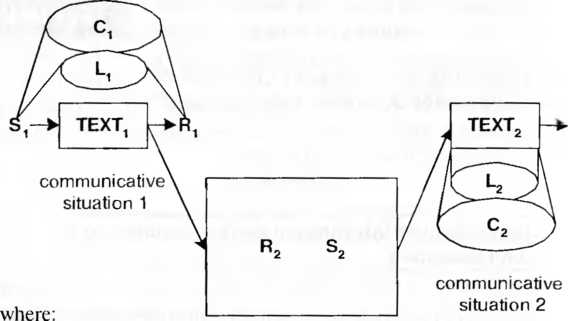
- •The unit of translation: compression and expansion in translating and interpreting
- •Translation of units of specific national/non-equivalent lexicon: the problem of translatability/untranslatability
- •Identification of International Lexicon Units
- •International terms
- •3) Translation of phraseological/idiomatic and metaphoric expressions
- •3. Translation by Choosing Genuine Idiomatic Analogies
- •4. Translating Idioms by Choosing Approximate Analogies
- •5. Descriptive Translating of Idiomatic and Set Expressions
- •4. The Translation Of The English Asyndetic Substantival Clusters (multicomponental attributive word groups).
- •5. Translation of Fiction
- •Introduction
- •Gaps in perception of oral discourse and ways of filling them in interpreting
- •9. Text cohesion, coherence and translation strategies
- •12. Translation definitions.
- •13. Principles and methods of training translators.
- •14. Notion of context in translation process.
- •15. Levels of equivalence and faithfulness in translation.
- •16. Textual pragmatics.
- •17. Translation and interpreting as interlingual and cross-cultural communication.
- •18. Semantic and syntactic algorithms of consecutive and simultaneous interpreters.
- •Semantic structure of the oral message and its mam components
- •4.2 The role of the rhematic components in comprehending
- •4.3 Rendering of the “evaluative component” of messages in interpreting
- •19. Metalanguage of translation theory. Translatology and linguistics.
- •§ 1, Возникновение современной теории перевода
- •§ 2. Теория перевода и литературоведение
- •§ 3. Теория перевода и лингвистика
- •§ 4. Теория перевода и сопоставительная стилистика
- •20. Interference of sl and tl. The notion of transformation in translating. Transformation model in translating.
- •§ 2. Перевод как процесс межъязыковой трансформации
- •22. Translation of scientific and technical matter. Machine translation.
- •23. Translation theories: Definitions and subject matter.
- •25. Translation criticism, literal and idiomatic translation. Foreigning and domesticating. Translationeses (translatees).
- •Varieties of close translation
17. Translation and interpreting as interlingual and cross-cultural communication.
From Maximov:
Interpreting as interlingual and cross-cultural communication
The process of translation (interpreting) is often described for practical reasons as a three-stage pattern [see Швейцер 1988: 49; Miram 1998: 57].
STAGE
1 STAGE 3
INCLUDEPICTURE
"../../../../../AppData/Local/Temp/FineReader11/media/image2.jpeg"
\* MERGEFORMAT INCLUDEPICTURE
"../../../../../AppData/Local/Temp/FineReader11/media/image2.jpeg"
\* MERGEFORMAT
STAGE
2
where Stage 1 ib communication between the original sender of information (source language sender or S ) and a translator (recipient of information or R,), Stage 2 is “code shifting” (transformations and finding equivalents, performed by a translator) and Stage 3 — communication between the translator (S2) and the final addressee (target language recipient2 or R,). According to this scheme there are two interrelated communicative acts in the process of translation (interpreting): communication between the initial sender of infor- H^ion and a translator and communication between a translator and the final addressee (recipient or receiver of information). In this process a translator is actlng 'n dual capacity all the time, acting as a recipient (at Stage 1 ) and as a Sender (at Stage 3) of the respective messages.
in f Shveitser ['988: 51] and ° Cherednychenko [20°7' 164 l65],follow- 8 Nida and C. Taber [1969], suggest another scheme of translation (in- station), which includes both linguistic and extrahnguistic factors and m ,.1 °^e much more relevant for our approach to interpretation. A slightly 1 ied version of this scheme is suggested below:
INCLUDEPICTURE
"../../../../../AppData/Local/Temp/FineReader11/media/image1.jpeg"
\* MERGEFORMAT INCLUDEPICTURE
"../../../../../AppData/Local/Temp/FineReader11/media/image1.jpeg"
\* MERGEFORMAT

S, — sender, (source language speaker);
R, - recepient, (source language recipient, addressee);
R2 — recepient (translator/interpreter in the mode of receiving in-comingmes sages)\
S2 — sender, (translator/interpreter in the mode of performing translating or interpreting);
R, —recepient, (target language recipient, addressee);
L, — language, (source language);
L2 — language, (target language);
C, — culture, (source culture);
C2 — culture, (target culture).
According to this scheme interpretation (as a kind of translation) maybe defined as a two-stage process of interlingual and cross-cultural communication, during which an interpreter, on the basis of an analysed and transformed text in L,, creates another text in Ц which substitutes the source text in the target language and culture. It should be also added to this definition that interpretation (as well as all other kinds of translation) is a process aimed at rendering of the communicative intent of the source text modified by the difference between two languages, two cultures and two communicative situations.
So an act of interpreting appears to be an act of cross-cultural communication, so far as cultures include the corresponding languages, languages include texts and texts pertain to specific subject fields (предметнігалузі)'- P0*1' tics, economics, business, law, teaching, engineering, information technologies, computer science, chemistry, mathematics, physics, agriculture, envi' ronmental protection, medicine, etc [see Бурак 2005; Бурак 2006].
